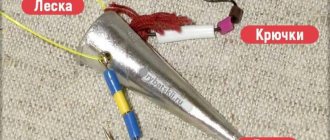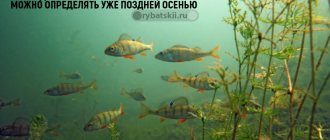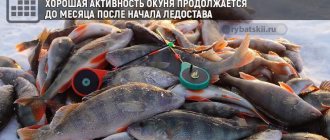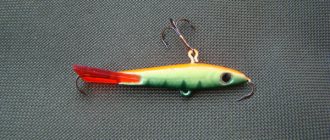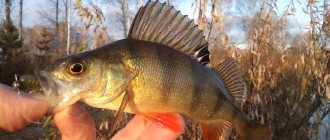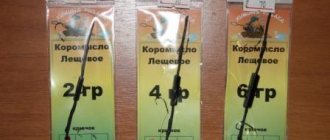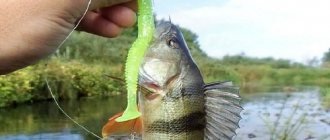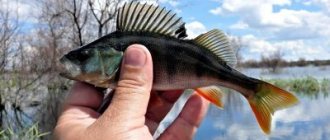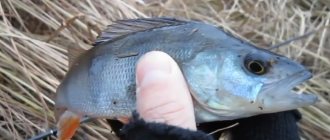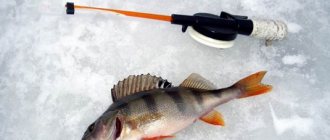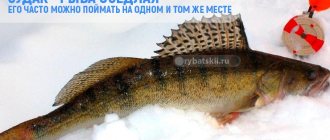Fishermen are creative and imaginative people. It’s impossible to count how many unusual fishing methods and baits they have come up with. “Balda” is one of these unusual baits. It is not known for certain when and where this bait first appeared. The Urals, Siberians, and fishermen from the Moscow region are fighting for the palm. Only one thing is known - the bulldozer is a common bait that has its loyal fans in different regions.
In winter fishing, the balda is known as one of the most effective gear for catching perch. They also successfully catch pike perch with it, and in some places large roach and bream.
What is a fishing rod
The bulldozer is an elongated weight with a thickening or expansion at the bottom, in the narrow part of which there is a transverse hole. A piece of thick and rigid fishing line is passed into the hole, onto which two free-hanging hooks are attached on either side of the weight. The hooks are positioned so that the tip points away from the weight. The fishing line is tied into a knot at the top, as a result of which there is a weight and hooks on the ring of fishing line that move freely along it.
The entire structure is tied to the main fishing line. Often, for ease of installation, a loop of fishing line is tied to winding rings or double-sided swivels. With short swings of the fishing rod and knocking the weight on the bottom, the free-hanging hooks move up and down along the line, attracting fish and provoking it to bite. A weight knocking on the ground raises a cloud of turbidity and imitates an insect or fish swarming at the bottom, and hooks falling down represent larvae raised from the bottom. When the bite is good, it happens that perches sit on both hooks at once .
Main elements of bait
Fishing in winter
Today we offer the topic: “fishing in winter” from professional fishermen. We tried to cover the topic as fully as possible. You can ask all questions in the comments after the article.
Balda is a simple tackle for perch that is easy to make with your own hands.
The winter fishing technique does not require special skills, and even a beginner will be able to fish.
Balda is a fairly effective tackle, especially in winter. It also has other names, for example, in Europe, fishing with a similar bait is called “vertical jig.” Despite the unsightly name, this is a catch bait, which consists of:
- an elongated lead weight (necessary to create sound and stir up the silt when falling to the bottom);
- two single hooks on the sides of the weight;
- colored cambrics or beads placed on hooks.
This entire structure slides freely along the fishing line.
The operating principle is as follows. When the weight falls to the bottom, firstly, a sound occurs - a dull thud, which attracts the attention of the fish, and secondly, a cloud of turbidity rises. The hooks, located on both sides of the weight, with their stings facing outward, rise and slide along the fishing line. The movement attracts the attention of the predator, which loves to feast on both bloodworms and hamarus, an amphipod crustacean. Hooks with stringed beads or multi-colored cambric successfully imitate this living creature. But other predatory fish come across the bulldozer, for example, pike perch, ruff, and sometimes even pike. It happens that even roach and crucian carp are caught with it.
There are several ways to attach hooks and weights:
- hinge mounting. All parts move freely along the line. The tackle resembles a beetle; the hooks, like insect legs, wave up and down, attracting the attention of the fish;
- On the top of the sinker there are soldered loops in which hooks are attached.
What kind of gear to take for fishing depends on the body of water. In the first variety the hooks “play”, in the second they bury themselves in the bottom mud along with the weight. Therefore, it is advisable to use this option on reservoirs with a rocky bottom.
However, the bait sold in stores is like the “average temperature in a hospital” and works under average conditions, which are extremely rare in real life. Therefore, there are actually a great many varieties of the correct bulldozer. You can even say - as many fishermen as there are, so many modifications that take into account the specifications of a particular body of water.
There are several points that will tell the fisherman which tackle will be the most correct for his case.
- The sinker is usually used oblong: cone, cylinder, truncated bullet, etc. The weight depends on the depth of the reservoir and ranges from 2-10 grams (depending on the speed of the current and the depth: fast current or greater depth, a larger weight is used and vice versa). Experienced fishermen who know the reservoir well prepare several types of bulldozer with weights of different weights.
- Weights are used from non-oxidizing metals: lead, copper, tin, tungsten, brass. Their shine in the water column also plays a role in attracting the attention of perch.
- The length of the hooks should be less than the sinker. Large hook eyes guarantee free sliding along the fishing line.
Some fishermen drill a hole in the bottom of the sinker and pour balls from the bearing. The result is a “rattle” that makes more noise, which means it is easier to attract the attention of fish.
For fishing on the bulldozer in winter, take a short fishing rod with a hard tip and a small spool of fishing line for use at different depths, for example, a simple “balalaika” or another fishing rod “according to the hand”. Line diameter is 0.2-0.25 mm. It can be monofilament, braided or even fluorocarbon. The last two have greater tensile strength compared to monofilament. To fix the bite, use a soft nod made of silicone tube. The length of the hooks ranges from 0.5 to 1.5 cm.
Making bait takes only 5 minutes for beginners, and 2-3 minutes for an experienced fisherman. To make one bulldozer, a fisherman will need:
- two hooks No. 6 or No. 8 with a wide eye;
- weight;
- fishing line with a diameter of 0.2 mm;
- thread;
- pliers;
- sandpaper (small piece);
- drill;
- drill 1.5-2 mm;
- beads.
Manufacturing process:
1. Measure the size of the weight. To do this, take the hook, apply it to the weight and bite it so that it is about 0.5-1 cm larger than the hook. The bitten top can be cleaned with sandpaper. A smooth weight looks more aesthetically pleasing and will not scratch the fisherman’s hands.
2. Make a hole in the top of the weight. For convenience, first make a small plus with pliers, and then drill a hole. 3. Carefully clean the hole from burrs.
4. Preparation of hooks. You need to string beads onto the hooks. Fish, especially predatory fish, have developed color vision, so it is advisable to place the first bead (near the ear) in contrasting white color to attract attention. Next we put red beads to make the hook look like a bloodworm.
The beads slide along the hook, so you need to secure them. Take the thread and wind it under the beads until they stop. We tie the thread into several knots and cut off the tails. We make the second hook in the same way. 5. Cut a piece of fishing line about 20-30 cm and collect the bulldozer. First hook, weight, second hook. Do not forget that the hooks must be correctly oriented, pointing away from the weight. We raise the tails of the fishing line, retreat 5-6 cm from the bulldozer and make a loop.
6. We retreat another 2-3 cm from the first loop and make a second loop. It should be double or triple.
The bulldozer is ready. For fishing, it is advisable to prepare 5-6 pieces at once.
The striped predator is found almost everywhere. He is very voracious and active almost all year round. However, in order to catch a fish, you need to know its habits and the topography of the bottom of the reservoir.
Periods of activity in winter are determined by the weather, in particular, air temperature:
- at the beginning of freeze-up, perch “grazes” at a depth of up to two meters. The predator is also attracted to the reeds where the young are hiding, so fishermen should look for it in a quiet backwater;
- when severe frosts come, the fish go deeper, because the water temperature is more stable there;
- As the weather warms, the striped predator returns to shallow waters.
The strategy for finding perch is quite simple:
- Drill holes at a distance of about 10 m from each other. In a small reservoir this is done by the banks towards the middle, in a large reservoir - in any direction.
- Fish every hole.
- When a perch is found, fish until the bite stops, then drill several holes in different directions from the “biting” hole, reducing the distance between the holes to one meter.
Baldu fishing is active fishing, and it is limited only by the physical capabilities of the fisherman, because he has to constantly drill new holes, actively moving along the ice.
The basis of the correct technique is playing with bait. The fisherman's movements should be smooth and measured. First you need to properly set up the rod and adjust the nod so that it is in a half-bent state. When casting, the weight hits the bottom, a dull sound is heard, and a cloud of turbidity is raised. The hooks lower smoothly, slower than the weight.
It is necessary to pause (no more than 10 seconds) so that the hooks also drop, and start playing. It is worth lifting the bulldozer slightly and dropping it to the bottom again. If after ten strokes there is no bite, move on to the next hole.
Monotony in fishing is unacceptable. Use different elements of the game: circular movements, shaking, pitching, changing the amplitude of the pulls and even jig play, only with low frequency and large amplitude, so that the hooks move but do not overlap. Alternate elements, create connections.
Winter fishing on Balda is an exciting activity for active fishermen. The bait is easy to make in a few minutes, and even a beginner, using simple recommendations, will please himself with a good catch.
Since perch is considered a predator, catching it is always interesting. But sometimes it happens that not all anglers know this method of winter perch fishing. This kind of gear is already practiced in winter fishing in many regions of the country and brings good results. With such bait you can catch not only perch, but also other predators. It is impossible to determine who invented this design, so they believe that it belongs to the people. However, there is no doubt about the effectiveness of the bulldozer during winter perch fishing.
Varieties of bait
Balda for catching perch differs in size and weight of weights. The body of the weight has a length from 1 to 5, and sometimes 7 centimeters. Accordingly, the mass of such cargo differs. The use of one size or another is often determined by the fishing location: depth and presence of current. The shape of the load is in the form of a bullet, pear, elongated bell or cylinder, but most often in the shape of a truncated cone. The wider and heavier part of the sinker is at the bottom point, thanks to this, when playing, the weight does not fall to one side and the hooks play freely.
The debate about whether it is necessary to paint weights and how this affects the bite continues. Most anglers are inclined to think that this is secondary. However, they are often painted red, black or green and combinations thereof. Unpainted weights made of stainless steel, brass or lead are also used.
The equipment of the hooks is of greater importance. Beads, beads, cambrics are put on them, and sometimes the forend is wrapped with thread. In general, the hook is equipped with elements in various combinations that attract fish. The shank of the hook can be filled with beads over the entire length or have one bead. There is no recipe for what is best. On the same body of water, even during the day, the preferences of perch change. Therefore, those who constantly catch perch on the bait have a whole arsenal of baits in different versions and change them during the fishing process. Preferred solutions can only be found based on experience.
It’s good when there are different types of bait and you can experiment
The fishing line used for the loop is rigid and thick, with a diameter of 0.2 - 0.5 mm. This loop does not stretch into one line, does not twist, and ensures free movement of the hooks. Fluorocarbon, which has the necessary characteristics, is often used.
Do-it-yourself making of a regular bulldozer and a spinner – a bulldozer.
The easiest way to become the owner of a bulldozer is to go and buy it at a fishing store. But, since real fishermen are never satisfied with the assortment of baits sold in the store, they have to make some of them at home by hand.
To make a bulldozer you need to make several bodies of different weights. There are two ways. First: go, again, to the store and buy several cone-shaped or spindle-shaped lead weights. Second: make a mold for casting from plaster. The second method is more labor-intensive, but allows you to make bold bodies of any shape.
After receiving the required number of blanks, they are processed with a file, rounding the upper and lower edges. Having retreated 2-5 mm from the narrow top of the resulting cone, we drill a through hole. You can make it in lead with an awl.
We select hooks for each bulldozer. The length of the hook should be shorter than the length of the body of the bulldozer. We put cambrics of different colors on the hooks. Next, we collect the tackle.
We thread the line sequentially: hook, weight, hook and tie a loose knot. The tackle is ready. You can go fishing.
It is more difficult to make a spinnerbait. You need to make a spinner first. The spinner should play and attract fish with its play, but when swung it should not go in different directions from the hole, but should fall at approximately the same point. Spoons with “loose” action have these properties.
Tips for fisherman: Is perch a river or sea fish - What is the difference, pros and cons
Spinner “Petersburg sleeper”
Loose play of a spinner (or “float”) is a play of a spinner when, after a swing, the spinner lies horizontally in the water column and in this position falls down, oscillating with its sides. There is either no or very little movement away from the hole. The spoon hits almost the same place on the bottom. Spinners with loose action: “Petersburg sleeper”, “diamond”, “half-diamond”, etc.
As soon as the hookless spinner with the required properties is ready, the hooks are attached in the same way as on an ordinary spinner.
It is difficult to make bold bodies from other materials and structures at home.
How to catch perch - we fish with live bait, spinning, feeder, and also catching this predatory fish in winter.
A basic guide to spinning for beginners - rules for choosing gear and bait.
We catch perch on a retractable leash: tackle, bait, fishing techniques in the next article.
It is best to start fishing with small baits, gradually moving on to large baits. This in turn will affect the size of the predator caught. Then you need to move to shallow river areas and use light bait. Closer to lunch, the fish goes aground, so you should look for it near the shore, in the grass and reeds.
Why is bait good?
Balda, like any non-standard bait, often catches perch when it doesn’t bite on anything else. Moreover, really large perch can be caught with it. Apparently, this is due to the fact that a seasoned humpback is already able to take something away from someone, regardless of those from whom he takes it. Moreover, this happens when he is not particularly active in order to grab balancers or spinners, and jigs are of little interest to him.
Pike or even grayling may be tempted by such bait.
As already mentioned, the bulldozer is good in currents and depths, that is, where humpback whales like to stand.
How to make a balda yourself
Balda is made independently by those who have accumulated experience in its use, and they already know what exactly they want from the bait. Experienced fishermen are sure that homemade bait is more effective than purchased bait.
Elements for making your own bulldozer
Preparing the weight
The simplest weight is made of lead, and for this it is not necessary to engage in casting. Take a sliding sinker weighing 5–20 grams, like an olive, flatten one side with a hammer, and make a transverse hole on the other side with a thin drill to allow the fishing line to pass through. One narrow end can be sawed off to widen the body of the sinker. A cone sinker is suitable; they are available in different weights. Saw off or bite off the top ring or swivel with pliers and drill a hole. If there is a suitable material - brass or stainless steel rods, then weights are made from them. True, this path is longer and more difficult, since hard materials require serious processing due to the need to use certain tools.
You can use a perch spoon as a load, but you need to “bite off” the hook with pliers first. The weight of the weight depends on the depth where the fishing will take place.
What should the hooks be like?
The main requirement for hooks is the presence of a wide eye. With a standard eye size, even if it seems that the hook slides freely, the bait will not work clearly. Such hooks in the water begin to “stick” to the fishing line and do not come down when playing. You don’t have to go too small with the size of the hooks; perch is not picky in this regard, but a large hook detects fish better. Hooks numbered 5 are suitable for equipping a bulldozer .
Assembling equipment step by step
Once the sinker and suitable hooks have appeared, take a piece of rigid fishing line. The first hook is threaded onto the fishing line, then the weight, then the second hook. When you lift the ends of the fishing line up, it turns out that the weight hangs in the middle, the hooks are on the side with the stings directed away from the weight. Some fishermen add one or two beads or beads on top of the hooks on the fishing line, which also move freely along the fishing line along with the hooks when playing.
Use thicker fishing line so that the hooks “walk” along it better. Diameter 0.20 mm. The main line is already 0.16-0.18 mm.
The ends of the fishing line are tied to a ring, or better yet, a swivel. This will allow you to conveniently tie the main line later. The size of the loop varies, depending on the weight and length of the weight, the size of the hooks, and the preferences of the angler. But more often there are rings with a diameter of 2–5 cm. A smaller diameter will not give the hooks freedom to play; a larger one, in principle, is possible.
Underwater photography of perch fishing in winter
The perch bite in winter depends on many factors. For example, on temperature indicators, oxygen saturation of the reservoir and, naturally, on the bait itself.
The wrong type of spinner and its performance can ruin all your efforts. Whereas, thanks to elevation photography, you can plunge into the real life of aquatic inhabitants and see how they react to this or that bait. Does the fish like it or does it scare it away? Only now will you have reliable information about the effectiveness of all fishing gear, so to speak, “the view from the inside.”
What fishing rod should I use for fishing?
Winter fishing rods with long whip
To catch perch in the winter on the boulder, fishing rods with long whips are used, allowing you to make clear strokes. Some fishermen fish without nods, however, its use is desirable, since the perch sometimes takes it quite delicately and there is a high probability of missing a bite.
Use a nipple or mylar nod, which has good shock absorption.
Perch fishing technique
The technique of fishing with a bulldozer is simple. Unwinding the fishing line, the fisherman finds the bottom with a weight. After this, the slack is removed so as to feel that the load is standing upright, but has not yet come off the bottom. This is followed by a short stroke of the brush and the bait sharply returns to its place, but again so that the load does not fall on its side. In order to control this moment, a nod is precisely what is needed. After a pause of 5–20 seconds, the next swing follows, and so on. The bite, as a rule, follows a pause, and often after several seconds. And the more passive the fish, the more pauses are made.
Mistakes you shouldn't make
Typical mistakes when fishing with balda in winter are excessive slack during pauses, when the weight falls on its side, dragging along the loop with hooks, which is why they do not move along the line and do not attract fish. The second common mistake is frequent swings, as when fishing with a spoon. Small pauses often prevent the hooks from descending all the way to the sinker.
If you haven’t fished with such wonderful tackle as the Balda yet, it’s time to try it. Balda often catches common baits and equipment in the most difficult situations.
